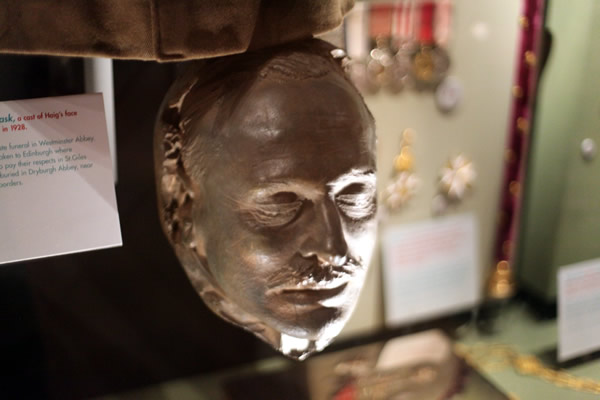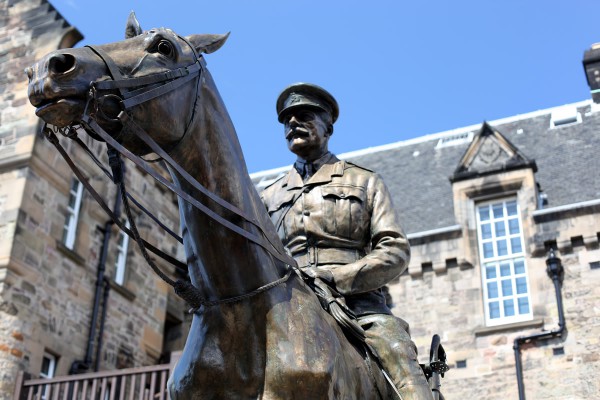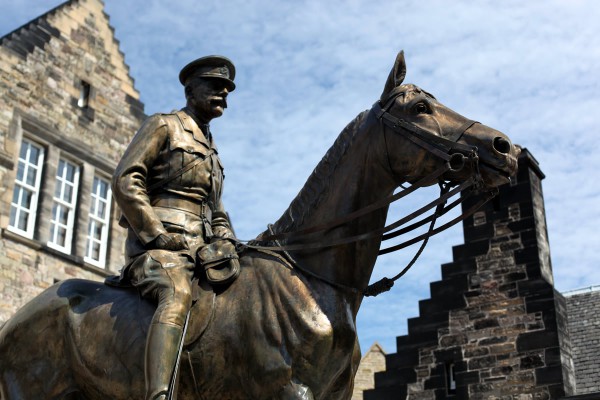On hilltop towering over much of Edinburgh, Scotland, is the city’s castle. The location is rich with military history, as the Scots and English fought over the castle and destroyed it on several occasions. Today, the castle acts as a large museum covering a wide range of Scottish history. Within it is the National War Museum, full of paintings and artifacts involving Scots from the medieval period to the modern era.
Finding the museum was a little tricky, as the castle has numerous layers accessible by slopes, stairs, and ledges. To add to the confusion there is a Scottish National War Memorial, which is at the highest point of the castle to the northwest. The National War Museum is on the lower northeast side.
When you tell a Scot you are looking for the War Museum, he or she can easily misconstrue your foreign accent to hear “War Memorial.” As such, I hiked all the way to highest point of the castle and was in awe of the memorial, but I wondered where the museum was. After getting directions from three different Scots and actually heading back uphill at one point, I finally figured out the confusion and arrived at the museum. The museum is easy to miss, as you have to walk down some stairs to get to a lower square that is not easily visible from the rest of the castle grounds.
In the middle of the square, resides an equestrian bronze statue of Field Marshall Sir Douglas Haig (1861-1928). I was unaware of the statue’s existence, but I had a hunch it was Haig as I approached. I simply could not think of any other prominent Scot in that style of uniform that could inspire such a monument. The structure is magnificent, surely fit for Gettysburg where we Americans boast seven such equestrian statues (See a few Gettysburg generals).
Criticism of Haig
Haig, a native from Edinburgh certainly deserves such a memorial, as he was very influential in the Allied military strategy during World War I (1914-1918). Even those unfamiliar with the war will at least have heard of the Somme (1916), an Allied assault conceived and commanded by Haig.
Yet, not everyone is appreciative of Haig’s service. In 2007, Military History magazine identified Haig as the “worst” general in history. ((Geoffrey Norman, “Field Marshall Sir Douglas Haig: The Worst General,” Military History 24 no. 4 (June 2007): 34.)) The article calls him a “butcher” and a “pompous fool.” ((Ibid., 41.)) Field Marshall Sir Bernard Montgomery (1887-1976) believed Haig was “unimaginative” and should have been relieved. ((Bernard Montgomery, A History of Warfare (New York: The World Publishing Company, 1968), 494.)) British military historian John Keegan believes Haig was “deficient in human feeling.” ((John Keegan, The First World War (New York: Alfred A. Knopf’s, 1999), 455.))
These are strong statements, but Haig was responsible for sending British soldiers to their death on a scale unprecedented in history and not even World War II (1939-1945) would change that stat. On the first day of the Somme (July 1, 1916), approximately 100,000 British infantrymen marched across the field against machinegun entrenchments and not one of them completed their objective. Instead, they suffered 60,000 casualties, including 20,000 dead. ((Ibid., 290-295.)) Over the next four and a half months, Haig continued the attack to the tune of more than 600,000 British and French casualties. All of this was for roughly seven miles of territory. ((Ibid., 298-299.))
Yet, lest we should think that such a record is not worthy of a statue, consider that at Gettysburg, there is a large statue of General Robert E. Lee, the loser of the battle. Regardless of the praise some heap upon Lee, I have yet to hear anyone claim that Lee’s final assault of the third day of the battle was the right move. By way of comparison, Montgomery believed Lee “was at his worst” during that battle. ((Montgomery 1968, 440.))
Regardless, Lee’s statue remains the grandest of all the generals at Gettysburg.
Was Haig heartless?
Based on historical narratives, Haig comes across as a heartless commander who did not value human life. Keegan believes that in Haig’s “public manner and private diaries no concern for human suffering was or is discernible.” ((Keegan 1999, 289.)) Yet, I have, on at least one occasion, found this not entirely accurate.
When I was researching Winston Churchill’s efforts to feed Germany after the First World War, I came across numerous letters and telegrams from journalists, politicians, and British officers with concern over the situation in Germany where the lack of food was causing starvation on a large scale. One in particular was from Haig, who on March 8, 1919, informed Churchill, “I feel sure that no time should be lost in sending supplies of food and raw material to Germany, if that country is to be saved from anarchy.” ((Letter from Haig to Churchill. Chartwell Papers 16/5/27.)) Heartless indeed.
Haig is one of those generals that when I read about him, I am horrified at the results of his battles. With hindsight, I can see that he was sending hundreds of thousands of young soldiers to their deaths with little return. Yet, he was not the only general in the war responsible for so many casualties. For example, at the Somme, the Germans also suffered roughly 600,000 casualties. Regardless, he was human and he did have concern for human suffering.
Below is Haig’s death mask from the National War Museum of Scotland.



